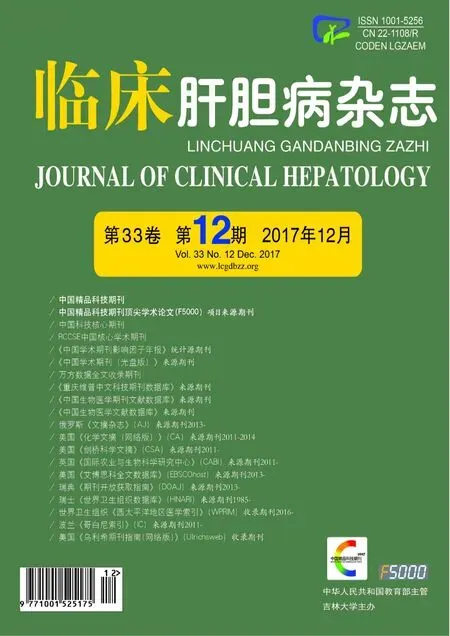8例肝淀粉样变性的临床病理分析
刘树红, 周光德, 郭超楠, 朱 莉, 张 潇, 赵景民
(解放军第三〇二医院 病理诊断与研究中心, 北京 100039)
8例肝淀粉样变性的临床病理分析
刘树红, 周光德, 郭超楠, 朱 莉, 张 潇, 赵景民
(解放军第三〇二医院 病理诊断与研究中心, 北京 100039)
目的探讨肝淀粉样变性的临床病理特征。方法收集解放军第三〇二医院2005年1月-2012年12月行肝穿刺活组织确诊的8例肝淀粉样变性患者,回顾性分析其临床资料、实验室检查、影像学以及病理学相关资料,归纳肝淀粉样变性的临床病理特点。结果临床表现及体征:肝肿大(7/8)、乏力(6/8)、纳差(6/8)、脾肿大(4/8)、腹水(2/8)、门静脉高压(2/8)、双下肢水肿(2/8)、皮肤瘙痒(2/8)、心脏病病史(2/8)、静脉曲张(1/8)。实验室检查:ALP升高(8/8)、GGT升高(5/8)、低蛋白血症(2/8)、ALT异常(2/8)、AST轻度升高(1/8)、TBil异常(1/8)。影像学检查:B超显示肝实质呈不均匀的回声图像(8/8)、瞬时弹性肝脏硬度检查显示明显增高(2/2)、CT显示弥散减弱(4/8)或局灶的减弱(2/8)。组织病理学和免疫病理学特点:HE染色在肝窦(8/8)及中央静脉周围(6/8)可见大量均染的粉红色样物质沉积,均染的粉红色物质刚果红染色为阳性(8/8),在偏振光显微镜下均染物质呈现苹果绿色,诊断为淀粉样变性;免疫组化Kappa染色阳性(6/8),Lamda染色阳性(4/8)。结论肝肿大和ALP的升高在原发性肝淀粉样变性患者中相对常见,当患者出现肝肿大、血清ALP升高且无法以常见的肝病明确诊断时,临床医师应该考虑肝淀粉样变性这一少见但致命的疾病,进而通过积极的相关检查,及早明确诊断,正确指导治疗。
肝疾病; 淀粉样变性; 疾病特征
淀粉样变性是一种多系统性疾病,淀粉样变是由原因不明的组织中纤维蛋白发生类似于淀粉遇碘变蓝的无定形嗜伊红物,可分为原发性和继发性[1-2]。原发性肝淀粉样变性实属少见[3],亦称为肝免疫球蛋白轻链型(AL型)淀粉样变性,由于其临床症状的不典型,临床诊断困难;继发性肝淀粉样变性相对而言更为多见,常表现为全身淀粉样变性的一部分[4]。淀粉样变性的确诊主要依靠活组织检查来确认淀粉样物质的存在,而刚果红染色阳性被认为是金标准。因此,通过对本院肝淀粉样变性病例的总结,并结合文献复习,能够更好地认识肝淀粉样变性的临床特点,为临床早期诊断提供线索和证据。
1 资料与方法
1.1 研究对象 收集2005年-2012年于本院经肝穿刺活组织病理检查确诊的肝淀粉样变性患者8例,其中男6例,女2例,年龄52~68岁。
1.2 诊断标准 光镜下观察病理组织,HE染色淀粉样物质呈粉红色;全部刚果红染色呈砖红色;在偏光显微镜下观察到绿色双折射物质,方可确诊为淀粉样变性。
1.3 观察指标及方法 收集患者的实验室检查指标(ALP、GGT、ALT、AST、TBil)、影像学、病理组织学以及免疫学相关资料。
2 结果
2.1 一般临床资料 所有患者病毒学指标均为阴性,无大量饮酒史,无明确的用药史,自身抗体阴性。既往1例患者曾诊断"心脏病、心肌肥厚、冠心病",1例患者心电图示"窦性心律伴房性早搏、心电图不正常,左前分支传导阻滞、ST-T改变",另有1例患者存在静脉曲张,余未见其他系统疾病病史。临床表现为肝肿大(7/8),乏力(6/8),纳差(6/8),眼黄(1/8),尿黄(1/8),脾肿大(4/8),腹水(2/8),门静脉高压(2/8),双下肢水肿(2/8),皮肤瘙痒(2/8),肝脏血管病变(1/8),心脏病病史(2/8),静脉曲张(1/8)。
2.2 实验室检查 ALP增高(8/8),GGT升高(5/8),低蛋白血症(2/8);ALT异常(2/8)、AST轻度升高(1/8)、TBil异常(1/8)。
2.3 影像学检查结果 B超显示肝实质呈不均匀的回声图像(8/8);瞬时弹性肝硬度检查显示明显增高(2/2);CT显示弥散减弱(4/8)或局灶的减弱(2/8);下腔静脉造影显示布加综合征(1/1)。
2.4 组织病理学和免疫病理学特点 8例患者均通过肝穿刺活组织病理检查、刚果红染色以及Lamda、Kappa免疫组化染色。HE染色在肝窦(8/8)(图1a)及中央静脉周围(6/8)可见大量均染的粉红色样物质沉积;均染的粉红色物质刚果红染色为阳性(8/8)(图1b);在偏振光显微镜下均染物质呈现苹果绿色(图1c),判定其为淀粉样变性;免疫组化Kappa染色阳性(6/8)(图1d),Lamda染色阳性(4/8)。2例瞬时弹性肝硬度检查显示明显增高的患者,在穿刺组织内1例可见肝小叶结构紊乱(图1e),1例可见纤维间隔的形成。





图1活组织病理检查a: 肝窦内大量均染的粉红色物质沉积(HE染色,×400);b: 均染的粉红色物质为阳性(刚果红染色,×400);c: 偏振光显微镜下观察,均染的粉红色物质呈苹果绿色(刚果红染色,×200);d: 免疫组化染色示Kappa阳性(Kappa染色,×400);
e: 肝小叶结构紊乱(HE染色,×200)
3 讨论
肝淀粉样变性主要是单克隆免疫球蛋白轻链(Kappa或Lambda)在肝组织中的过量沉积,主要沉积在肝实质内、肝窦内、中央静脉、门静脉间质和细胞间隙内[5-8],进而导致肝肿大、肝功能异常、腹水和门静脉高压、肝衰竭,甚至死亡[9]。现已证实,至少有25种蛋白可作为前体蛋白引起淀粉样变性[10]。
本研究中所有患者均>40岁,年龄最小为52岁,多数患者入院前曾因多种症状就诊于不同医院,均未得到明确诊断,最终以肝功能异常等为主诉来本院就诊。8例患者均不同程度的出现乏力、纳差等非特异性病变,较多患者出现肝肿大,部分患者出现脾大、门静脉高压、腹水等,Wang等[5]研究认为肝肿大程度、疾病严重程度以及肝功能异常与患者存活率均无关,而Bion等[10]认为门静脉高压是肝淀粉样变性的不常见症状,一旦出现常提示预后较差。本研究中所有患者均出现ALP水平升高,伴或不伴有GGT的显著升高,而ALT和AST仅见少数患者轻度升高。文献[11-12]报道的肝淀粉样变性患者ALP、GGT升高达94.7%(18/19) ,尤其是ALP进行性升高可能和预后有关,而ALT和AST轻度异常或正常可帮助与其他肝病相鉴别。影像学检查也是诊断肝淀粉样变性的重要手段,但由于缺乏特异性的影像学特征,肝淀粉样变性常被误诊,本研究中有1例患者行下腔静脉造影报告为布加综合征。肝淀粉样变性患者入院时,通过其临床表现和相关检查资料很难确诊,通常要和病毒性肝炎、药物或毒物类肝损伤、自身免疫性肝病等疾病相鉴别,但最终确诊仍需要行活组织检查,光镜下观察到HE染色呈粉红色,刚果红染色呈砖红色时方确诊为淀粉样变性。
综上所述,肝淀粉样变性的预后较差,主要取决于患者的治疗时机和病变类型,发病后未经治疗仅能存活1~2年,中位生存时间为10~14个月[13]。肝淀粉样变性的主要治疗方案为美发仑+强的松的标准治疗以及对症支持治疗[14],早期诊断有利于提高疗效,避免器官功能进行性恶化。因此,对于临床上有不明原因肝肿大、ALP明显升高的患者,在综合评估后,有必要行肝活组织病理检查及特异性组织学染色(刚果红染色),以明确诊断,及早开展治疗。
[1] MERLINI G, BELLOTTI V. Molecular mechanisms of amyloidosis[J]. N Engl J Med, 2003, 349(6): 583-596.
[2] EBERT EC, NAGAR M. Gastrointestinal manifestations of amyloidosis[J]. Am J Gastroenterol, 2008, 103(3): 776-787.
[3] HIRANO K, IKEMURA M, MIZUNO S, et al. Two cases with hepatic amyloidosis suspected of having primary sclerosing cholangitis[J]. Hepatol Res, 2013, 43(8): 911-916.
[4] SARSIK B, SEN S, KIRDOK FS, et al. Hepatic amyloidosis: morphologic spectrum of histopathological changes in AA and nonAA amyloidosis[J]. Pathol Res Pract, 2012, 208(12): 713-718.
[5] WANG YD, ZHAO CY, YIN HZ. Primary hepatic amyloidosis: a mini literature review and five cases report[J]. Ann Hepatol, 2012, 11 (5): 721-727.
[6] WEE JW, JEONG SW, JANG JY. Hepatic amyloidosis presenting as a large hepatic mass[J]. Clin Gastroenterol Hepatol, 2012, 10(9): e73-e74.
[7] SON YM, CHOI JY, BAK CH, et al. 18F-FDG PET/CT in primary AL hepatic amyloidosis associated with multiple myeloma[J]. Korean J Radiol, 2011, 12(5): 634-637.
[8] SON RC, CHANG JC, CHOI JH. Primary hepatic amyloidosis: report of an unusual case presenting as a mass[J]. Korean J Radiol, 2011, 12(3): 382-385.
[9] LOUSTAUD-RATTI VR, CYPIERRE A, ROUSSEAU A, et al. Non-invasive detection of hepatic amyloidosis: FibroScan, a new tool[J]. Amyloid, 2011, 18(1): 19-24.
[10] BION E, BRENARD R, PARIENTE EA, et al. Sinusoidal portal hypertension in hepatic amyloidosis[J]. Gut, 1991, 32(2): 227-230.
[11] JANSSENS F, SPAHR L, RUBBIA-BRANDT L, et al. Hepatic amyloidosis increases liver stiffness measured by transient elastography[J]. Acta Gastroenterol Belg, 2010, 73(1): 52-54.
[12] FAUST D, AKOGLU B, RISTIC G, et al. Ursodeoxycholic acid for treatment of cholestasis in patients with hepatic amyloidosis[J]. Vojnosanit Pregl, 2009, 66(6): 482-486.
[13] YIM B, KERTOWIDJOJO E, ZHANG Y, et al. Poor outcomes in hepatic amyloidosis: a report of 2 cases[J]. Case Rep Oncol Med, 2016, 2016: 7625940.
[14] KUMAR SK, GERTZ MA, LACY MQ, et al. Recent improvements in survival in primary systemic amyloidosis and the importance of an early mortality risk score[J]. Mayo Clin Proc, 2011, 86(1): 12-18.
Clinicopathologicalfeaturesofhepaticamyloidosis:ananalysisof8cases
LIUShuhong,ZHOUGuangde,GUOChaonan,etal.
(DepartmentofPathologyandHepatology, 302HospitalofPLA,Beijing100039,China)
ObjectiveTo investigate the clinicopathological features of hepatic amyloidosis.MethodsA retrospective analysis was performed for 8 patients with hepatic amyloidosis confirmed by liver biopsy in 302 Hospital of PLA from January 2005 to December 2012. Clinical data, laboratory examination results, imaging findings, and pathological data were analyzed to summarize the clinicopathological features of hepatic amyloidosis.ResultsThe clinical manifestations and signs of this disease included hepatomegaly (7/8), weakness (6/8), poor appetite (6/8), splenomegaly (4/8), ascites (2/8), portal hypertension (2/8), edema of lower extremities (2/8), pruritus (2/8), a history of heart disease (2/8), and varices (1/8). Laboratory examination showed increases in alkaline phosphatase (ALP) (8/8) and gamma-glutamyl transpeptidase (5/8), hypoproteinemia (2/8), abnormal alanine aminotransferase (2/8), a slight increase in aspartate aminotransferase (1/8), and abnormal total bilirubin (1/8). As for imaging examinations, ultrasound showed uneven echo of liver parenchyma (8/8); transient elastography showed a significant increase in liver stiffness (2/2); CT showed diffuse weakness (4/8) or focal weakness (2/8). As for histopathological and immunopathological features, HE staining showed the deposition of pink substances around the hepatic sinusoids (8/8) and the central vein (6/8), Congo red staining of the pink substances obtained a positive result (8/8), and the pink substances showed a color of apple green under a polarization microscope; therefore, the patients were diagnosed with amyloidosis. As for immunohistochemistry, of all patients, 6 had positive Kappa staining and 4 had positive Lamda staining.ConclusionHepatomegaly and elevated ALP are relatively common in patients with primary hepatic amyloidosis. When a patient has hepatomegaly and elevated ALP and cannot be diagnosed with common liver diseases, clinical physicians should consider the possibility of hepatic amyloidosis, which is rare but fatal, and make a confirmed diagnosis based on related examinations, in order to provide guidance for clinical treatment.
liver diseases; amyloidosis; disease attributes
R575.5
A
1001-5256(2017)12-2381-03
10.3969/j.issn.1001-5256.2017.12.025
2017-05-26;修回日期:2017-06-22。 作者简介:刘树红(1980-),女,主治医师,主要从事肝病病理方面的研究。 通信作者:赵景民,电子信箱: jmzhao302@163.com。
引证本文:LIU SH, ZHOU GD, GUO CN, et al. Clinicopathological features of hepatic amyloidosis: an analysis of 8 cases[J]. J Clin Hepatol, 2017, 33(12): 2381-2383. (in Chinese)
刘树红, 周光德, 郭超楠, 等. 8例肝淀粉样变性的临床病理分析[J]. 临床肝胆病杂志, 2017, 33(12): 2381-2383.
(本文编辑:邢翔宇)

